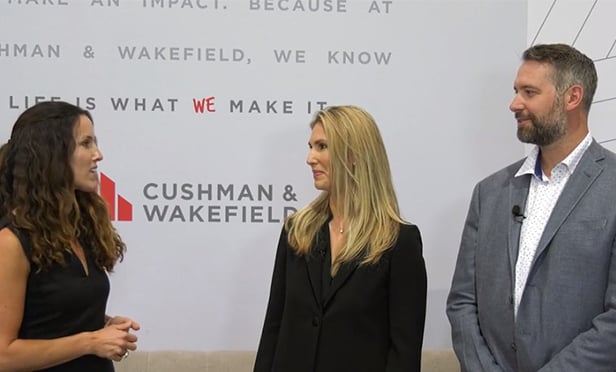
NEW YORK CITY—James Nelson of Cushman & Wakefield sat down with Martha Stark, policy director for Tax Equity Now NY and former New York City finance commissioner to discuss the inequality of the New York City property tax system, how taxes are currently being calculated and how they should be calculated, and the implications for both residential and commercial space.
James Nelson: Martha, please tell us a about your coalition and its mission.
Martha Stark: Tax Equity Now in New York was formed earlier this year and is a group of all kinds of owners, apartment building owners, co-op owners, condo owners, all of whom cannot figure out New York City's property tax. Essentially, this group came together because they feel like the system is broken. It is increasingly harder to understand, but more importantly it has some inequities that really need to be addressed. We figured out that the best way to get changes would be to a file lawsuit. Elected officials, speaker, the mayor, everyone has been decrying how terrible the system is and difficult it is to explain but yet not doing anything at all. We feel like the court is an important tool and mechanism for both saying what the inequities are and which ones need to be addressed and then putting pressure or bringing pressure to make sure something different happens.
Nelson: That certainly makes sense. Where does the suit stand right now and what would it take for your group to prevail?
Stark: We filed the lawsuit on April 25 against the Department of Finance—my former agency—the State Office of Real Property Tax Services, which is an agency within the state department of taxation and finance, and then the City of New York, the State of New York and the mayor and the governor's offices. On July 7, the city and state filed a motion to dismiss the action, and we have until the end of August to respond to their motion to dismiss. We think the motion to dismiss was really not the way to go given how many people have said that the system is broken. It is certainly a litigation tool that people are using, but we think we are probably going to survive the motion to dismiss, and then we will get to the place where they file an answer and we get to discovery. It will take a little while but it is really important that it move forward.
Nelson: Tell us a little bit about how properties are currently assessed and then how would your group propose changing that.
Stark: Judge Lippman, former Head of the Court of Appeals here in New York, is a part of the litigation team. He is at Latham & Watkins and he explains it pretty simply. He says that essentially the property tax is supposed to be based on market value and that your taxes should bear some resemblance or some connection, some relationship to what your market value is. In its simplest form the City is supposed to estimate what is market value. We have four different tax classes. First class is one, two and three family homes. The second class is apartment buildings, rentals, co-ops and condos. Class three is utility property and class four is commercial property.
In 1981, they created those four classes and they have one rule saying that all property within each class had to be uniform within that class. What is interesting about that is that there is no uniformity, and uniformity is a pretty straightforward concept. It actually has some technical ways that you calculate it. From a taxation perspective, it means that like properties should have like taxes. If my house is worth $700,000, I should be paying the same tax as someone else who has a house that's worth $700,000 and that is not how this system works. In fact, we looked at several properties that sold for $750,000 in one year. In one instance, the tax was as low as $1,500, and in another instance, it was as high as $20,000. Next we looked at several properties that pay $4,300 in taxes. The range of value for these properties was from $150,000 to $9 million. There is absolutely no uniformity in the system.
Second thing that I just want to point out is the homeowner class within the rental apartment building class. There is another rule in the city that says co-ops and condos cannot be valued based on their sales price. Instead, you to have find a comparable rental property. For example, a Central Park West property selling for $30 million is getting compared to a rental property, because those co-ops and condos were built during rent regulation time. They are actually finding a rent regulated apartment to compare them to. There are many instances where the Department of Finance actually values the entire building for less than what one unit sells for in a building. That creates a huge problem in the apartment building class because it means that rental buildings are actually subsidizing these high valued co-ops and condos. That is a major issue.
Nelson: It seems like you have really landed on something that for once landlords and tenants can agree on, the taxes are too high now. I know part of the suit also talks about the impact on minority neighborhoods and how they have also faced an unfair amount of the tax burden. How has that come to pass?
Stark: There are people paying 25 to 35 percent of their gross income for taxes alone. Within the homeowner class, because it is a classified system, there are rules that limit how much assessments can increase each year. I live in a co-op in Parksville where values have gone up a lot, but the values in Canarsie or Brownsville, where I grew up, are not going up that much. The assessments are able to keep up in Brownsville and Canarsie but not keep up in Parksville. As a result, that leads to places like Canarsie and Brownsville paying a much higher effective tax rate than places like Parksville.
The same thing is true again for rental property. There is no cap on how much the city can raise on taxes, and so they will raise your assessment consistent with, to some extent, your income going up. That also has created disparities. This notion of co-ops and condos not being valued based on sales price results in renters picking up that huge burden.
Nelson: Savills did a study showing the average tax per square foot for office product in Manhattan is $16.40 whereas in San Francisco, it is $5.75. The national CBD average is $6. Most of the New York City property taxes in office buildings are pushed onto the tenants. Why is the New York City CBD almost triple the national average?
Stark: In Manhattan, commercial properties have a property tax and a commercial rent tax that gets paid by tenants and such. The commercial rent tax was implemented when the city bumped up against its property tax limit. There is a cap on how much tax revenue the city can raise from the property tax.
Manhattan rents, especially in Midtown, were at $100 dollars which is also two and a half to three times what the average was around the rest of the country. But, Manhattan is the place to be and I think you raise legitimate concerns about what is the appropriate burden of taxes for everybody.
© 2025 ALM Global, LLC, All Rights Reserved. Request academic re-use from www.copyright.com. All other uses, submit a request to [email protected]. For more information visit Asset & Logo Licensing.








